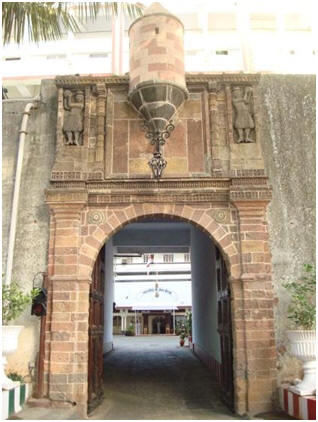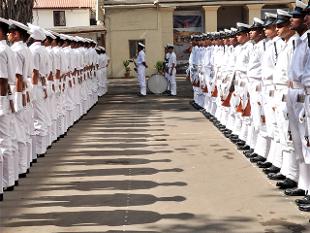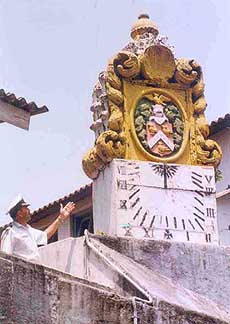INDIA
DEFENCE CONSULTANTS
|
WHAT'S
HOT? –– ANALYSIS OF RECENT HAPPENINGS |
|
INS ANGRE TURNS 64 An IDC Report |
|
New Delhi, 22 Sep 2015
MUMBAI: Indian Naval Ship Angre, a naval establishment here, which currently functions as the main 'base and depot' establishment for the Western Naval Command, celebrated its 64th anniversary today. Navy officers and civilians, who worked together at the establishment, celebrated the day in naval style, after the statue of Maratha navy's founder admiral Kanhoji Angre, was garlanded by Rear Admiral S P Lal, VSM, Admiral Superintendent of Naval Dockyard (Mumbai), according to an official release issued here.
A 'badakhana' and a variety entertainment programmes were also organised as part of the celebrations.The history of the port city of Mumbai and INS Angre are closely linked. It was here that the potential of erstwhile Bombay as a port city was first recognised by the British colonial administration. Though it was only in 1940 that Castle Barracks were commissioned as HMIS Dalhousie and declared as a complete naval station, the Bombay Castle (as INS Angre was once called) has an even older history. In 1543, the Sultan of Gujarat ceded the island of Bombay to the Portuguese, who built a fort on the island. However, most of the village of Bombay was leased to the famous Portuguese botanist physician, Gracia da Orta whose Manor House is still visible in parts. Later, Manor House played an important role in the history of Bombay city. It was here that the treaty of cessation was signed on February 18, 1665, between Humphrey Cooke and the Portuguese, handing over Bombay to King Charles II of England as part of the dowry to be received by him after his marriage to princess Catherine Braganza of Portugal. When Manor House had belonged to the Portuguese, it had braved attacks by Dutch, English and Arab forces. After the British East India Company took charge of Bombay Castle in 1668, they enlarged and fortified it further, until it became the headquarters of the East India Company in 1686. The fort is also said to have been used in battles by the British against the Marathas. The present name of the base (acquired in 1951) is most significant since it is named after the famous Maratha admiral Kanhoji Angre during Chhatrapati Shivaji's rule. Bombay Castle had grown, both in size and importance. A town has come up around the castle while fortifications and moats sprang up around it forming what is known as the Fort area today. It was also during the time of the British East India Company that ship building in and around the Fort area received great impetus. Remnants of the past are still visible within premises of INS Angre and some Portuguese era relics have survived the test of time. These include massive weather--beaten two-storey wooden gates, which is the entrance to INS Angre, carved figures of pantalooned Portuguese soldiers, a rocket shaped lookout tower and an approximately ten-feet high sundial, with grotesque carving of heads of men, monsters and animals.
The walls of the fort, 23 feet at the base, are the most impressive of all, which were made of stone, probably granite and sand stone from Rajasthan, due to which they have most admirably withstood the ravages of time and tide. Many of these original structures have been preserved as they were at the time of Independence, such as the 150 years old brass cannons, main doors, fort walls and sundial. However, some changes have also been made over time, since dungeons which were once used to keep pirates and other defaulters have been converted into offices and stores. During the function, Commodore Suprobho De, Commanding Officer of INS Angre said that the Indian Navy is committed to preserve the premises to accentuate its heritage value, history and semblance of its past. The historical Indian Navy base will continue to be a centre of great naval maritime activity as it has been for over the past four centuries, he said. Historical Background In the 16th century AD, Bombay was an archipelago of seven marshy islands which were leased by the King of Portugal, who got possession of the island from Gujarat monarchy in 1534, to his compatriot Garcia de Orta, a famous botanist-physician in 1548. He built a wooden permanent structure called Manor House, which was the first modern construction of Bombay. The re-built Manor House in INS Angre, today, is the seat of the Flag Officer Commanding-in-Chief, Western Naval Command. During the early times, the area around the Manor House consisted of a sea front wall and four guns mounted on it and it became known as the Castle Barracks. The British became the masters of the islands of Bombay when the Portuguese gave them in dowry to his Majesty King Charles II for the marriage of Catherine of Braganza, of Portugal and the Manor House officially became the seat of power of the British Empire in 1665. The islands of Bombay came into the possession of the East India Company on September 23, 1668. The Company shifted its headquarters from Surat to Castle Barracks in 1686. In 1830, the naval ensign then known as the ‘Company Jack’ was hoisted on the Castle for the first time when the Bombay Marine was re-designated as the Royal Indian Navy. In 1940, the Castle was commissioned as HMIS Dalhousie and renamed as INS Dalhousie on January 26, 1950. The establishment was renamed as INS Angre on September 15, 1951 in the honour of great Maratha Admiral Kanhoji Angre. Even after more than four centuries, the Castle Barracks still retains some of the original structures and relics. Functions/Role INS Angre, is the shore based logistics and administrative support establishment of the Western Naval Command. This establishment carries out the duties and functions of the base depot ship for the Command. The establishment is also known as the Naval Barracks and provides multifarious facilities to all ships and units based at Mumbai. The Commanding Officer of this establishment is also known as the COMBRAX (Commodore Naval Barracks), who exercises full jurisdiction over the Naval properties at south Mumbai and carries out the functions of the Station Commander, South Mumbai. INS Angre is like a mother ship which controls and oversees the functioning of a wide array of diverse units and facilities. Some of the allied units of Angre are listed below:- (a) WNC (O) Mess. (b) Indian Naval Sailors Home ‘Sagar’. (c) All accommodation built for Sailors in Navy Nagar at South Colaba. (d) All accommodation built for Naval Officers in NOFRA at South Colaba. (e) Command Swimming pool in South Mumbai. (f) Naval Transport Pool (g) Schools such as Naval KG, Little Angles I, II, III, IV and Kendriya Vidyalaya I. (h) Station Cdr ECHS (Ex-Servicemen Contributory Health Scheme) Headquarters, Angre. (j) Hostels such as Naval Girls Hostel, Boys Hostel, Working Women’s Hostel and Widows Hostel. The administrative and logistics support functions undertaken by this unit touch the lives of every officer, sailor, civilian and their family members posted in this Command.
|


